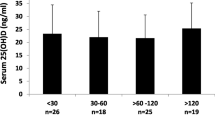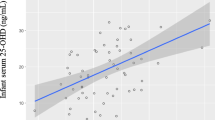Abstract
Objective
To correlate the sunlight exposure in first 6 months to vitamin D status at 6 months of age in predominantly breastfed infants; and to quantify the sunlight exposure required to achieve serum 25(OH)D level >20 ng/mL, by 6 months of age
Design
Prospective cohort.
Setting
Tertiary-care hospital predominantly catering to urban poor population in Delhi.
Participants
132 healthy infants, delivered at term, and predominantly breastfed were enrolled at 6-8 weeks of age. Of these, 100 infants were available for final evaluation at 6 months of age (mean (SD) follow-up: 126 (17) days).
Methods
Baseline maternal vitamin D (serum 25(OH)D) levels were obtained at enrolment. The mothers were asked to maintain a daily record of duration of sunlight exposure, timing of exposure, and body surface area exposed, for the infant, on a pre-designed proforma, till the child was 6 months of age. Infant’s serum 25(OH)D was measured at 6 months of age.
Main outcome measures
Cumulative Sun Index was calculated as a composite measure of overall duration/time/body surface area exposed to sunlight; and correlated with the infant serum 25(OH)D after adjusting for baseline maternal serum 25(OH)D levels, season of exposure, and skin color of the infant. Sun index for exposure in morning (before 10 am) and afternoon (10 am-3 pm) were also correlated to vitamin D status.
Results
Of 100 mother-infant pairs completing the study, 90 mothers had vitamin D deficiency (serum 25(OH)D <12 ng/mL). The median duration of exposure of infants to sunlight was 17 min per week, on 6% of body surface area. Vitamin D levels of 67 (67%) infants at 6 months were less than 12 ng/mL and another 23% had insufficient levels (12-20 ng/mL). Cumulative sun index correlated positively to infant’s serum 25(OH)D level at 6 months of age (r= 0.461, P<0.001). Increment in afternoon sun index by 1 unit increased the serum 25(OH)D level by 1.07 ng/mL (95% CI 0.37, 1.78; P= 0.003). A minimum 30 minute weekly afternoon sunlight exposure, between 10 am and 3 pm, over 40% body area (infant clothed in diapers, in prone position) for at least 16 weeks, was estimated requirement to achieve sufficient vitamin D levels (>20 ng/mL) by 6 months of age.
Conclusions
There is a significant positive correlation between afternoon sunlight exposure and infant’s vitamin D levels, independent of maternal vitamin D status. Randomized controlled trials are suggested to explore the effectiveness of this simple intervention to prevent or treat vitamin D deficiency in children.
Similar content being viewed by others
References
Millen AE, Bodnar LM. Vitamin D assessment in population-based studies: a review of the issues. Am J Clin Nutr. 2008;87:1102S–5S.
Jain V, Gupta N, Kalaivani M, Jain A, Sinha A, Agarwal R. Vitamin D deficiency in healthy breastfed term infants at 3 months and their mothers in India: seasonal variation and determinants. Indian J Med Res. 2011;133:267–73.
Bhalala U, Desai M, Parekh P, Mokal R, Chheda B. Subclinical Hypovitaminosis D among exclusively breastfed young infants. Indian Pediatr. 2007;44:897–901.
Balasubramanian S, Shivbalan So, Kumar PS. Hypocalcemia due to vitamin D deficiency in exclusively breastfed infants. Indian Pediatr. 2006;43:247–51.
Wagner CL, Greer FR. American Academy of Pediatrics Section on Breastfeeding; American Academy of Pediatrics Committee on Nutrition. Prevention of Rickets and Vitamin D Deficiency in Infants, Children, and Adolescents. Pediatrics. 2008;122:1142–52.
Armas LA, Dowell S, Akhter M, Duthuluru S, Huerter C, Hollis BW, et al. Ultraviolet-B radiation increases serum 25-hydroxyvitamin D levels: the effect of UVB dose and skin color. J Am Acad Dermatol. 2007;57:588–93.
Rossberg W, Saternus R, Wagenpfeil S, Kleber M, März W, Reichrath S, et al. Human pigmentation, cutaneous vitamin D synthesis and evolution: Variants of genes (SNPs) involved in skin pigmentation are associated with 25(OH)D serum concentration. Anticancer Res. 2016;36:1429–37.
Institute of Medicine. Dietary reference intakes for calcium and vitamin D. Washington, DC: The National Academies Press; 2011.
Fitzpatrick TB. The validity and practicality of sun-reactive skin types I through VI. Arch Dermatol. 1988;124:869–71.
Determining Depth and Percentage of Burn Injuries. Available from: https://www.firefighternation.com/forum/topics/889755:Topic:2902596. Accessed May 24, 2014.
Nurbazlin M, Chee WS, Rokiah P, Tan AT, Chew YY, Nusaibah AR, et al. Effects of sun exposure on 25(OH) vitamin D concentration in urban and rural women in Malaysia. Asia Pac J Clin Nutr. 2013;22:391–9.
Barger-Lux JM, Heaney RP. Effects of above average summer sun exposure on serum 25 (OH)-D and calcium absorption. J Clin Endocr Metab. 2002;87:4952–6.
Steichen JJ, Tsang RC, Gratton TL, Hamstra A, DeLuca HF. Vitamin D homeostasis in the perinatal period: 1,25-dihydroxyvitamin D in maternal cord and neonatal blood. N Engl J Med. 1980;302:315–9.
Lamberg-Allardt C, Larjosto M, Schultz E. 25-Hydroxyvitamin D concentrations in maternal and cord blood at delivery and in maternal blood during lactation in Finland. Hum Nutr Clin Nutr. 1984;38:261–8.
McCarty CA. Sunlight exposure assessment: can we accurately assess vitamin D exposure from sunlight questionnaires? Am J Clin Nutr. 2008;87:1097S–101S.
Goswami R, Saha S, Sreenivas V, Singh N, Lakshmy R. Vitamin D-binding protein, vitamin D status and serum bioavailable 25(OH)D of young Asian Indian males working in outdoor and indoor environments. J Bone Miner Metab. 2016 Jan 30. [Epub ahead of print].
Holick MF. Environmental factors that influence the cutaneous production of vitamin D. Am J Clin Nutr. 1995;61:638S–45S.
Holick MF. Sunlight and vitamin D for bone health and prevention of autoimmune diseases, cancers, and cardiovascular disease. Am J Clin Nutr. 2004;80:1678S–88S.
Specker BL, Valanis B, Hertzberg V, Edwards N, Tsang RC. Sunshine exposure and serum 25-hydroxyvitamin D concentrations in exclusively breast-fed infants. J Pediatr. 1985;107:372–6.
Hall LM, Kimlin MG, Aronov PA, Hammock BD, Slusser JR, Woodhouse LR, et al. Vitamin intake needed to maintain target serum 25-hydroxyvitamin D concentrations in participants with low sun exposure and dark skin pigmentation is substantially higher than current recommendations. J Nutr. 2010;140:542–50.
Alshahrani FM, Almalki MH, Aljohani N, Alzahrani A, Alsaleh Y, Holick MF. Vitamin D: Light side and best time of sunshine in Riyadh, Saudi Arabia. Dermatoendocrinol. 2013;5:177–80.
Author information
Authors and Affiliations
Corresponding author
Rights and permissions
About this article
Cite this article
Meena, P., Dabas, A., Shah, D. et al. Sunlight exposure and vitamin D status in breastfed infants. Indian Pediatr 54, 105–111 (2017). https://doi.org/10.1007/s13312-017-1010-9
Received:
Revised:
Accepted:
Published:
Issue Date:
DOI: https://doi.org/10.1007/s13312-017-1010-9




